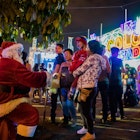
Apr 16, 2025 • 7 min read
Wi-fi, mobile networks and eSIMs make data access in Colombia easy – this guide has key tips for staying connected.

Apr 16, 2025 • 7 min read
Wi-fi, mobile networks and eSIMs make data access in Colombia easy – this guide has key tips for staying connected.

Mar 6, 2025 • 4 min read
The climate varies across the country, but each season provides a good reason to visit Colombia. Here is the best time to visit.

Mar 5, 2025 • 9 min read
From tropical beaches to kinetic cities and pristine jungles, Colombia packs quite a punch. Plan your trip around these unmissable places.

Feb 28, 2025 • 11 min read
Colombia attracts record numbers of visitors with its incredible landscapes, vibrant cities, and warm welcome. These are top things to do.

Feb 26, 2025 • 8 min read
The biggest danger when visiting Colombia? You might never want to leave. As you plan your trip, these tips will help you make the most of your trip.

Apr 10, 2024 • 7 min read
Here’s how to get off the beaten track and discover the best of the magnificent Colombian rainforest.

Oct 2, 2023 • 8 min read
Colombia's landscape is stunning and impressive but those features can be hard to navigate on the ground. Here's how to get around Colombia.

Oct 2, 2023 • 11 min read
Discover the family-friendly side of Colombia with these age-appropriate destinations and activities for unforgettable vacations with kids.

Sep 30, 2023 • 6 min read
Colombia is one of the best-value destinations in South America. Stretch your cash even further with our top tips on how to visit on a budget.

Sep 23, 2023 • 5 min read
With its warm, welcoming atmosphere and jaw-dropping national parks and beaches, Colombia is a joy to visit, Here's what you need to know about visas.

Sep 21, 2023 • 8 min read
From incredible mountainous landscapes to stunning uncrowded beaches, Colombia has some once-in-a-lifetime road trips. Here are 5 of the best.

Aug 16, 2023 • 10 min read
With coastline trails and dizzying high-altitude scenery, explore Colombia with these top hiking routes.

Jul 29, 2023 • 5 min read
Colombian cuisine reflects the incredible cultural and geographic diversity of the country. Here are the best foods to try when you're there.

Feb 22, 2023 • 6 min read
If you’re dreaming about Colombia, this itinerary from Elsewhere by Lonely Planet will inspire you to pull the trigger and go.

Nov 15, 2022 • 10 min read
Colombia’s 59 protected natural areas are a must for nature lovers. Ocean Malandra shows you how to see two parks in four days.

Sep 24, 2022 • 8 min read
If you want to climb an active volcano, visit archeological sites, go scuba diving or much more, Colombia’s extraordinary national parks beckon.

Sep 15, 2022 • 4 min read
A look at the new Sofitel Barú Calablanca: Cartagena's first luxury beachfront resort, focused on relaxation.

Aug 8, 2022 • 5 min read
Time moves slowly here, but there’s plenty to do, from tubing down the Rio Palomino to hiking with local indigenous tribes

Mar 29, 2022 • 10 min read
Whether you’re drawn to Colombia by the culture, hiking, wildlife or cities, you’ll want to linger to enjoy the beaches. Here's our pick of the best.

Mar 25, 2020 • 8 min read
It’s a place of legends and liquid rainbows, but until 10 years ago the brilliantly hued river known as Caño Cristales was located deep in FARC territory.

Jan 23, 2020 • 6 min read
Hosting terrain as untamed as the country’s one-time reputation, Colombia’s emergence from the travel wilderness means vast areas await exploration.

Nov 19, 2019 • 8 min read
Colombia comes alive with bright Christmas traditions in this first person account of a family experiencing festivals, markets, street food, and more in…